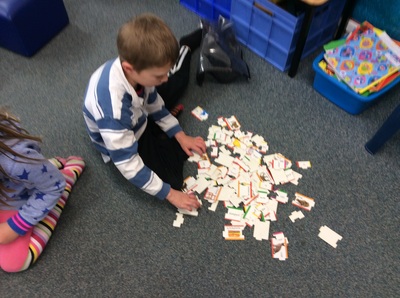As students learn to read they use knowledge, skills & strategies to decode written texts.
Students will
· learn about letter-sound knowledge, vocabulary, sentence structure, text structure, and content
· demonstrate that they are using these targets in an integrated way as they respond to the texts they read
· develop automaticity as they gain more control of these skills and their reading becomes more accurate and fluent
· use their cognitive resources to think about the meaning of what they read
· extend their personal knowledge and integrate new information and ideas, using their conclusions to inform their own thinking
· read a variety of texts as they engage with the curriculum
· work with more complex texts as they gain knowledge, skills and strategies
Students will
· learn about letter-sound knowledge, vocabulary, sentence structure, text structure, and content
· demonstrate that they are using these targets in an integrated way as they respond to the texts they read
· develop automaticity as they gain more control of these skills and their reading becomes more accurate and fluent
· use their cognitive resources to think about the meaning of what they read
· extend their personal knowledge and integrate new information and ideas, using their conclusions to inform their own thinking
· read a variety of texts as they engage with the curriculum
· work with more complex texts as they gain knowledge, skills and strategies
Reading in Years 1-2
For most of our New Entrant students, we begin by teaching them Letter-Sound Knowledge (the sounds that letters make). For this, we use a fun, multi-sensory programme called Jolly Phonics. Alongside learning phonics, students will be learning all about the ‘Concepts of Print’. This means they will listen to stories, talk about them, look at the pictures, differentiate between words, letters and pictures, find finger spaces, full stops etc. Once children have learned most of the initial letter sounds, they will move onto the next phonics stage where we use the ‘Yolanda Soryl Programme’. In this next stage, students will learn to read and write simple 3 letter words. Alongside our phonics programme, students will learn to read 'tricky words'. Tricky words are those words that you can’t sound out (eg ‘the’, ‘go’) and will need to learn by sight. We spend time in the classroom learning to read (and then spell) these words. There are 3 further phonics stages (along with 72 ‘tricky words’) that your child will be working their way through. Students will be exposed to a range of reading material in class. At times, they will bring home a reader to share their learning.
For most of our New Entrant students, we begin by teaching them Letter-Sound Knowledge (the sounds that letters make). For this, we use a fun, multi-sensory programme called Jolly Phonics. Alongside learning phonics, students will be learning all about the ‘Concepts of Print’. This means they will listen to stories, talk about them, look at the pictures, differentiate between words, letters and pictures, find finger spaces, full stops etc. Once children have learned most of the initial letter sounds, they will move onto the next phonics stage where we use the ‘Yolanda Soryl Programme’. In this next stage, students will learn to read and write simple 3 letter words. Alongside our phonics programme, students will learn to read 'tricky words'. Tricky words are those words that you can’t sound out (eg ‘the’, ‘go’) and will need to learn by sight. We spend time in the classroom learning to read (and then spell) these words. There are 3 further phonics stages (along with 72 ‘tricky words’) that your child will be working their way through. Students will be exposed to a range of reading material in class. At times, they will bring home a reader to share their learning.
Reading in Years 3-8
Guided reading lessons develop overall reading competence where students 'read, respond to, and think critically about texts’ at a specific curriculum level. For example, by the end of year 4, the texts will be those that students need to read 'to meet the reading demands of the New Zealand Curriculum at level 2'. A student nearing the end of year 4 could be expected to read appropriate texts selected to support learning in any area of the curriculum at that level.
Endeavour and Explore sessions are also designed to meet the key purposes for students’ reading and may focus on the different targets as they carry out curriculum-related tasks. At each year level, these purposes increase in complexity and scope.
Tasks, like texts, become more complex as students consider ideas and information in different ways. There is a 'gear shift' from locating and evaluating items of information on a topic through to locating, evaluating, and synthesising information from several different sources.
Guided reading lessons develop overall reading competence where students 'read, respond to, and think critically about texts’ at a specific curriculum level. For example, by the end of year 4, the texts will be those that students need to read 'to meet the reading demands of the New Zealand Curriculum at level 2'. A student nearing the end of year 4 could be expected to read appropriate texts selected to support learning in any area of the curriculum at that level.
Endeavour and Explore sessions are also designed to meet the key purposes for students’ reading and may focus on the different targets as they carry out curriculum-related tasks. At each year level, these purposes increase in complexity and scope.
Tasks, like texts, become more complex as students consider ideas and information in different ways. There is a 'gear shift' from locating and evaluating items of information on a topic through to locating, evaluating, and synthesising information from several different sources.





